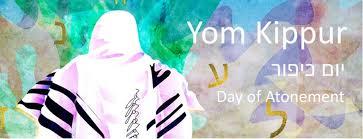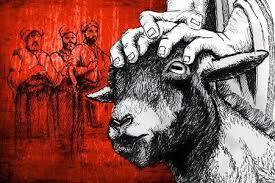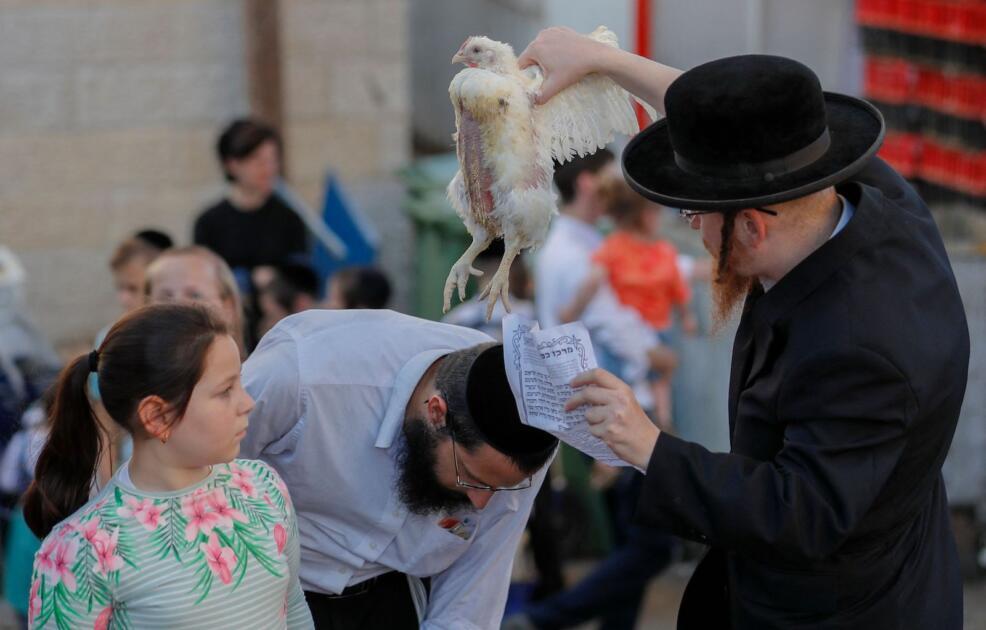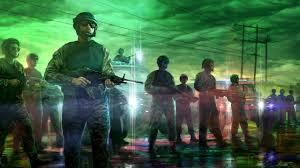Yom Kippur (The Day of Atonement)
23: 26-32
Yom Kippur DIG: Why is The Day of Atonement the most holy day of the year? What was the purpose of this feast? What was so important about the preparation for it? Why must the nation of Isra’el experience affliction? What are the Messianic implications for them?
REFLECT: When have you had to go through affliction to reach the point of repentance? What did you learn? How can your lesson help others? Who can you help this week? How are the principles taught by the Day of Atonement valid for the B’rit Chadashah believer?
Yom Kippur will be fulfilled by the Great Tribulation.

Following the blowing of the shofars to assemble the people (to see link click Ee – Rosh ha’Shanah), was, and continues to be, the most holy day of the year for Isra’el – Yom Kippur. The details of the festival of The Day of Atonement can be seen in Chapter 16 (Co – Yom Kippur: The Removal of All Sin). Leviticus 23:26-32 is a separate message from Chapter 16, and emphasizes the spiritual preparation for the day and not all the details of the atonement which were covered earlier.457 To see a video presentation of Yom Kippur click here.
The Biblical practice: ADONAI said to Moshe, “The tenth day of the seventh month (Tishri) is Yom Kippur; you are to have a holy convocation” (23:26-27a). This day was set aside for the removal of all the sins of the people. The slate was wiped clean, so to speak, and the people had the opportunity to make a fresh start for the following year. Of course, the people could find forgiveness for sin and spiritual renewal at any time of the year, but given the extent of sin and defilement, known and unknown, it was wonderful to have one day where all of it could be taken care of all at once.
But there would be no spiritual renewal if the people did not prepare their hearts for it. David said that ADONAI desires a broken and contrite heart, and not just the outward ritual of sacrifice (Psalm 51:17-19). Therefore, the people were instructed to afflict their souls (Hebrew: vein-nitem nafshoteichem) which the CJB translates you are to deny yourselves (23:27b). The expression is rather harsh, for this expression means to afflict, punish, or treat harshly. It is interpreted here to mean that the people should follow a total fast and abstain from the pleasures and comforts they normally enjoyed because these were incompatible with repentance, confession, and atonement. In this way they were contributing to the effectiveness of Yom Kippur and not simply relying on the work of the priests.
YHVH adds that spiritual renewal is based on sacrificial atonement. And you are to bring an offering made by fire to ADONAI (23:27c). There would be no forgiveness of sin without the shedding of blood (Hebrews 9:22b), and the blood had to be shed from God’s appointed sacrificial offering; as stated above, Chapter 16 gives the details. The provision for this spiritual renewal was expressed through animal ritual: one goat was sacrificed on the bronze altar and another goat was taken away into the wilderness. In this way the confessed sins were completely removed.
The principles taught by the Day of Atonement are valid for the B’rit Chadashah believer; sin must be regularly removed in order for spiritual service and fellowship to take place. John instructs us that if confess our sins, He is faithful and just and will forgive us our sins and purify us from all unrighteousness (First John 1:9). Beyond that, sin can only be removed through Messiah’s eternal sacrifice (see the commentary on Hebrews Cd – Messiah’s Sacrifice Was Once for All Time). Not annually.
The Day of Atonement was also a time of complete rest – no work of any kind could be done at that time. You are not to do any kind of work on that day, because it is Yom-Kippur, to make atonement for you before ADONAI your God. And anyone who does any kind of work on that day, I will destroy from among his people. You are not to do any kind of work, for it is considered a Sabbath day; it is a permanent regulation through all your generations, no matter where you live. Since it is called a Shabbat, the general customs for the Sabbath are in order. It will be for you a Shabbat of complete rest, and you are to deny yourselves; you are to rest on your Shabbat from evening the ninth day of the month until the following evening (23:28 and 30-32). YHVH made clear distinctions between the secular and the sacred. The people were to devote themselves to spiritual concerns, in fact, the most important spiritual concern: finding atonement from God. It has always been true that people need to come away from their daily routines in order to give full attention to their spiritual life. And on the higher meaning of these principles the writers of the B’rit Chadashah explain that works of any kind, no matter how good or righteous, are of no value in finding atonement and entering His rest.458
The text adds that anyone who does not deny himself on that day is to be cut off from his people (23:29). For only Ha’Shem knew the hearts of the people and could discern who had actually afflicted their souls. In rabbinic literature the penalty is called karet, or “cutting off.” In priestly literature, the penalty of karet was understood to include a series of related punishments at the hand of God, ranging from the immediate death of an offender, as in 20:17, to his premature death at a later time, and even to the death of his descendants. In Mishnah Sanhedrin 9:6 and Mishnah Keritot 1:2, this penalty was considered as mitah biydei shamayim, or “death at the hands of heaven.” Since in 7:20-21 karet is mentioned in the context as childlessness, there is the implication that it took that course as well.459
The Jewish Observance: Yom Kippur is considered the logical extension of what was started at Rosh ha’Shanah. In fact, the ten days between Rosh ha’Shanah and Yom Kippur take on their own holy significance. They’re called the Yomim Nora’im, the Days of Awe. Traditional Jews, as well as many non-traditional Jews, spend these days looking inward, seeing how their inner life might be more pleasing to God. Personal relationships are evaluated; forgiveness and restitution are offered where needed. Reconciliation is attempted.
As the evening of the tenth of Tishri approaches, special preparations are made. Leviticus 23 states that on Yom Kippur, Isra’el is to humble your soul. This is taken (based on the Hebrew word oni) to mean fast. In the context of Isaiah 58:5, this word is used specifically for going without food.
Before sundown, when the fast begins, it is customary to have a holiday meal. In fact, it’s a requirement in order to make the fast day set apart! As with the other holy days, the table is set with the best linens and dishes. White is still an appropriate color for linens and clothing. It symbolizes the holy of the High Holy Days, the cleansing from our sins (Isaiah 1:18). Two candles are lit and the blessings are said over the wine and the challah bread.
After the festive meal, just before dark, at twilight, Yom Kippur begins along with the fast. The fast continues from sundown on the ninth of Tishri until sundown on the tenth. For many Jews that means no food, not even water. Jews are encouraged to abstain from all luxuries for those twenty-four hours. No unnecessary bathing, entertainment, sex, etc. Please note that the rabbis are quick to point out that the fast is only applicable to healthy adults past bar or bat mitzvah age (thirteen). Anyone with a health problem or who is pregnant or nursing is exempted from the fast.
The evening of the holy day (Erev Yom Kippur) is perhaps the most holy occasion of the spiritual year. Jews flock to the local synagogues to attend Kol Nidre service. Kol Nidre is a special cantorial prayer asking Ha’Shem for release from any vows that have been taken inappropriately (see Fa – Holiness of the Vow). The origin of the petition dates back to the Middle Ages when many Jews were forcibly converted into the Church, yet still wanted to maintain their connection with their people. The evening service continues with traditional prayers and songs from the Jewish prayer book calling Isra’el to atonement in God.
Yom Kippur day takes on the feel of a most holy Shabbat. Jewish worshipers continue the fast that started the previous evening and likewise attend synagogue services all day. The traditional liturgy, prayers and music emphasize the theme of the day, the need for atonement for sins. The services last most of the day for it is believed that judgment will come at the close of Yom Kippur. The prayers fervently request that, as Jews, they would be written in the Book of Life for one more year.
The holy day closes with an important Neilah service (the closing of the gates). The final blast of the shofar is sounded. It is thought that the fate of each individual is sealed at that time for the upcoming year. Naturally, the hope is for a sweet and blessed spiritual year, which is illustrated in the breaking-the-fast meal, which follows sundown. Sweet wine is tasted first, which is blessed in the traditional manner. Next, the sweet challah or honey cake is eaten as a reminder of the sweet new year that they hope to experience. For most Jews, this is at best an optimistic hope that their sins have been atoned for. Believers in Yeshua, however, can rejoice in the confidence that He, the Messiah, has indeed paid the price that ADONAI required.460

During Temple times, the high priest would sacrifice identical goats. One goat was brought as a sacrifice in the Temple, while on the other goat (see Cv – The Goat for Azazel), the high priest laid his hands and confessed the sins of the nation. Afterwards, a representative of the people would take the Azazel goat into the desert to die. Since the earliest days of Jewish observance of Yom Kippur, the ritual of the two goats had occupied a central role in the Yom Kippur service. But once the Second Temple was destroyed (see the commentary on The Life of Christ Mt – The Destruction of Jerusalem and the Temple Remembered on Tisha B’Av in 70 AD), this practice stopped and a substitute was needed.

Today many Orthodox Jews practice an atonement ritual called kapparot on the eve of Yom Kippur. This is a practice where a chicken is waved over the heads of both men and women, and then slaughtered in accordance with halachic rules and then donated to the poor for a pre-Yom Kippur meal. Psalm 107:17-20 and Job 33:23-24 are recited along with a prayer, saying, “This is my exchange, this is my substitute, this is my atonement. This chicken will go to its death, while I enter and proceed to a good and long life and to peace.”

The Future Affliction of the Great Tribulation: Here, the implications of the festival to the Jews in the Great Tribulation are in view. During the Great Tribulation people will desperately seek religion because of the chaos in the world at that time. As ADONAI’s judgments devastate the earth and terrorize its inhabitants, people will frantically turn to the beast as their savior. He will lead a worldwide campaign to destroy every last Jew and attempt to replace God on the earth. The beast (the antichrist) and the ten horns (one world government) you saw will hate the prostitute. They will bring her to ruin and leave her naked (Revelation 17:16a).
John saw another beast (the false prophet), coming out of the earth. He will deceive people into worshiping the antichrist and establish a worldwide religion. The false prophet will have two horns like a lamb (giving the appearance of a true religious leader) but he will speak like a dragon (Satan). He will exercise all the authority of the first beast (the antichrist) on his behalf, and will make the earth and its inhabitants worship the first beast (Revelation 13:11-12). Therefore, context will determine how the beast is interpreted. When this is understood, the book is much easier to read and much easier to understand.
We see the woman (see the commentary on Revelation Dd – I Saw a Woman Holding a Golden Cup in Her Hand, Filled with the Filth of Her Adultery) riding the beast (One World Government) before the Great Tribulation. During the first three-and-a-half years of the Great Tribulation, the false religious system will have the support of the civil government led by the antichrist seen in Revelation 17:1-18. However, after forty-two months the beast (the antichrist) will have consolidated his power, and he will declare himself to be god and turn on the woman, destroying her so that the unholy trinity of Satan, the beast (the antichrist) and the false prophet will be able to rule without sharing their power with anyone (see Revelation Ek – The Beast Will Hate the Prostitute and Bring Her to Ruin).
During this study it has been pointed out that modern Judaism teaches the affliction of the body, though the Scriptures teach it is affliction of the soul. God, however, is going to bring both afflictions with the fulfillment of the Day of Atonement. The Passover was fulfilled by the death of Messiah; The Feast of Unleavened Bread was fulfilled by the sinlessness of His bloody offering; the Feast of First Fruits was fulfilled by the resurrection of Yeshua, the Feast of Weeks was fulfilled by the birthday of the Church. The first cycle of feasts was fulfilled with Messiah’s First Coming. Then between the first cycle and the second cycle there is a four-month interval that is symbolic of the Age of the B’rit Chadashah that interrupts the program of the feasts of Isra’el. Then comes the second cycle of holy festivals. The Feast of Trumpets will be fulfilled by the Rapture of the Church, and the Day of Atonement will be fulfilled by the Great Tribulation.461
The Messianic Significance: The Day of Atonement will be fulfilled by the Great Tribulation. To better understand this, it is helpful to review the biblical practice and the Jewish observance. First, the key word is affliction. In the case of the biblical practice, the affliction was that of the soul. In the case of the Jewish observance, the affliction is of the body. Secondly, is the concept of atonement. On the Day of Atonement, it was not an individual atonement, but a national atonement. By the sacrifice of the two goats, national atonement was made for the people of Isra’el. But the national atonement would not be effective if there wasn’t the affliction of the soul by the individual. Salvation is always by grace alone, through faith alone, in Messiah alone. So, while the blood of the goat provided atonement for the nation as a whole, it was applied only to the righteous of the TaNaKh.
Another example of this is in the Levitical sacrificial system. Salvation is, and has always been, on the basis of faith; faith in the Dispensation of Torah and faith in the Dispensation of Grace. When an Israelite went to the Tabernacle or the Temple to make an offering, YHVH only accepted it if the person did so on the basis of faith. It was not accepted if the person was only going through the motions. Without faith it is impossible to please God (Hebrews 11:6). A piece of meat on the bronze altar meant nothing without faith. It’s like a person going through the motions at their place or worship. Just because you sit in the garage, it doesn’t make you a car!
Dear Heavenly Father, How wonderful that it is by faith that we can please and not by the quantity of our works. Our love and faith work together to produce a strong desire to please You by our works. My heart is heavy for family and friends who know about You and who think of you as a good and loving father, but they do not have any love for You. Please let them have a moment of spiritual clarity so they can see You for who You really are. They want Your love without giving it back. But salvation cannot be earned in any way by our works, it is the gift given in love and must be received by faith (Ephesians 2:8-9). In holy Yeshua’s name and power of His resurrection. Amen
The key word in relation to the Great Tribulation is affliction. In the Tribulation there will be an affliction of the body of Isra’el and affliction to the soul of Isra’el. In the last three days of the closing of the Great Tribulation (Hosea 6:1-2), the leadership of Isra’el held up at Bozrah, will finally realize that the reason they have suffered so much is because of the rejection of Yeshua Messiah. As the armies of the antichrist encircle them to wipe them from the face of the earth, the Israelites will repent and cry out for Yeshua to return (see my commentary on Revelation Ev – The Basis for the Second Coming of Jesus Christ). At that point all Isra’el will be saved (Romans 11:26), and Yom Kippur will be fulfilled because the blood of Messiah will have atoned for Isra’el’s sins by faith. Some believers fast on Yom Kippur, not because they need to obtain forgiveness, but to pray for the salvation of Isra’el (Romans 10:1).462
After Rosh ha’Shanah comes Yom Kippur; after repentance comes regeneration. Such is the promise for all Isra’el as she will supernaturally experience the fulfillment of Yom Kippur and the return of Yeshua Messiah (Romans 11:25-27). For all believers, we wait expectantly for the return of our Kosher King! What a picture of Yom Kippur! We can rejoice in the atonement now, while we wait for the blessed hope (Titus 2:13).
The Feast of Passover was fulfilled by the death of Messiah, the Feast of Unleavened Bread was fulfilled by the sinlessness of His sacrifice, the Feast of First Fruits was therefore fulfilled by the resurrection of Christ life, Shavu’ot was fulfilled by the birth of the Church, the Feast of Trumpets will be fulfilled by the Rapture of the Church, and the Day of Atonement will be fulfilled by the Great Tribulation.
A Practical Guide for Believers in Messiah: For believers in Yeshua, both Jewish and Gentile, the observance of Yom Kippur can hold special significance. The repentance started at Rosh ha’Shanah comes to a culmination with atonement ten days later. As with the traditional Jewish community, those ten days (Yomim Nora’im) can take on spiritual meaning as they meditate on the meaning of the High Holy Days. Although there are not many customs directly relating to the ten days, the message could be applied to a believer’s daily meditation at that time. Traditional reading from the book of Jonah, Hosea 14 and other pertinent passages can enhance one’s appreciation of the season.
Regarding the Yom Kippur fast, some believers question if fasting is appropriate since they are already forgiven in Messiah. True, believers do not fast to obtain forgiveness, yet there are some benefits for fasting nonetheless. Yeshua spoke of the blessings of a fast. Although the question of salvation is already settled by faith in Yeshua, believers are still in constant need of returning to a pure walk with the Father. Fasting can sensitize our spirits to His heart.
Many Messianic Jews and Gentiles fast on Yom Kippur for another reason also. As it is the one day of the religious year on which Jews around the world are packed into synagogues and praying, many believers have found it to be a special day to pray for the salvation of Isra’el. As Paul wrote to the believers in Rome: Brothers, my heart’s deepest desire and my prayer to God for Isra’el is for their salvation (Romans 10:1).
The evening of Yom Kippur is a wonderful time for a Messianic worship service. For those who live near a Messianic Congregation, attending a formal Yom Kippur service can be a spiritual highlight. The music, liturgy and message all celebrate the true meaning of the day: atonement in Yeshua Messiah! If you are unable to attend such a group, why not plan your own service for your family and friends. You have the greatest textbook for planning such a celebration: your own Bible. Choose some songs and Scriptures that accentuate the theme of forgiveness in Yeshua. Combined with the fasting and prayer, any group has the potential for an inspiring Yom Kippur service.
By the following day, the stomach is testifying that this is a serious time of seeking God. For those who want the full Jewish experience, continue the fast, even without water until sundown. Yom Kippur day is another time for worship services with a community of believers. The theme is the same: repentance and (for believers) rejoicing in God’s plan of forgiveness.
The afternoon might be spent at home resting and further meditating on the importance of the day. Our Messianic congregation has a tradition of meeting together for the final hour of daylight for a Neilah service (the closing of the gates). This had proven to be a rich time of corporate prayer and worship as we read from a Messianic siddur (prayer book), the Scriptures, and sing songs of praise to our Redeemer. As the sun sets to close Yom Kippur, we bless the wine (grape juice) and the challah (bread); thus, the first things we taste after the feast are sweet. Then we have a “break-the-fast” potluck dinner as a fitting celebration to this holy day. Blessed be ADONAI-Elohim, who has secured our salvation in Yeshua Messiah. That is what Yom Kippur is all about for those who call on His Name.463



Leave A Comment